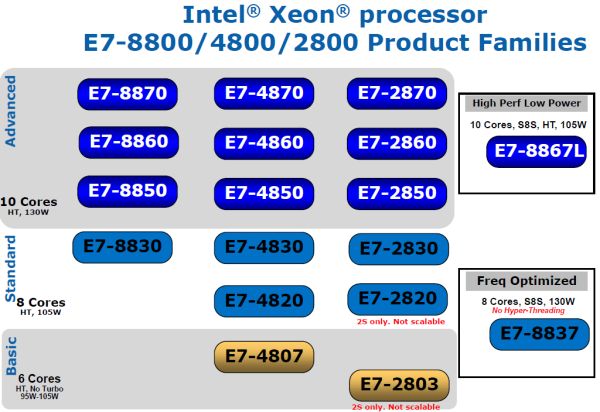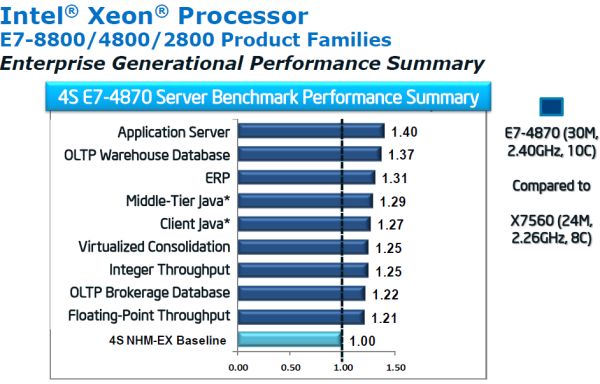Westmere-EX: Intel Improves their Xeon Flagship
by Johan De Gelas on April 6, 2011 2:39 PM EST- Posted in
- IT Computing
- Intel
- Nehalem EX
- Xeon
- Cloud Computing
- Westmere-EX
Westmere-EX SKUs and Performance
Intel has three general classifications for the new 10-core processors. The E7-x870 runs at 2.4GHz and has a 30MB L3, while the E7-x860 runs at 2.26GHz and the E7-x850 runs at 2.13GHz; the lower clocked models are also downgraded to a 24MB L3. As there are versions for 8-, 4-, and 2-socket servers, we get nine new SKUs. Pricing on the highest end 8-socket models is very high, but that's not too surprising for the target market: the E7-8870 costs $4616, the E7-8860 goes for $4061, and the E7-8850 comes with a "bargain" price of $3059. For quad-socket chips, you can knock that down about $225, and dual-socket chips will reduce prices another $175 or so.
What this means is pricing for the fastest Xeons has increased by about $1000, a clear sign that Intel does not expect any competition in the small but profitable high-end x86 market. And indeed, the current AMD "Magny-cours" is targeted at the midrange server market, not the high-end. Bulldozer will be AMD's attempt to take on these new Xeon models, and it probably won't attack this high-end market before the end of the year.
Also present is a low power E7-8867L, which runs 10 cores at 2.13GHz but needs 105W instead of the 130W of the E7-8850. For the 25W drop in TDP, the price jumps up to $4172.
The E7-8837 is another interestin processor. It has eight cores and forgoes Hyper-Threading, so it's like the Nehalem-EX but with a 2.67GHz clock it runs 18% higher than the fastest Nehalem-EX CPUs. Thus, it looks like the 45nm to 32nm transition either delivers two extra cores and a 6% clockspeed increase, or it improves clocks by 18% with the same number of cores. Below is the complete table of new SKUs.
| Intel Xeon Westmere Specifications and Features | ||||||
| Processor Number | Frequency | L3 Cache | Cores / Threads | Turbo / HTT | TDP | 1kU Pricing |
| Xeon E7-8870 | 2.4GHz | 30MB | 10 / 20 | Yes / Yes | 130W | $4,616 |
| Xeon E7-8860 | 2.26GHz | 24MB | 10 / 20 | Yes / Yes | 130W | $4,061 |
| Xeon E7-8850 | 2.00GHz | 24MB | 10 / 20 | Yes / Yes | 130W | $3,059 |
| Xeon E7-8830 | 2.13GHz | 24MB | 8 / 16 | Yes / Yes | 105W | $2,280 |
| Xeon E7-8867L | 2.13GHz | 30MB | 10 / 20 | Yes / Yes | 105W | $4,172 |
| Xeon E7-8837 | 2.67GHz | 24MB | 8 / 8 | Yes / No | 130W | $2,280 |
| Xeon E7-4870 | 2.40GHz | 30MB | 10 / 20 | Yes / Yes | 130W | $4,394 |
| Xeon E7-4860 | 2.26GHz | 24MB | 10 / 20 | Yes / Yes | 130W | $3,838 |
| Xeon E7-4850 | 2.00GHz | 24MB | 10 / 20 | Yes / Yes | 130W | $2,837 |
| Xeon E7-4830 | 2.13GHz | 24MB | 8 / 16 | Yes / Yes | 105W | $2,059 |
| Xeon E7-4820 | 2.00GHz | 18MB | 8 / 16 | Yes / Yes | 105W | $1,446 |
| Xeon E7-4807 | 1.86GHz | 18MB | 6 / 12 | No / Yes | 95W | $890 |
| Xeon E7-2870 | 2.40GHz | 30MB | 10 / 20 | Yes / Yes | 130W | $4,227 |
| Xeon E7-2860 | 2.26GHz | 24MB | 10 / 20 | Yes / Yes | 130W | $3,670 |
| Xeon E7-2850 | 2.00GHz | 24MB | 10 / 20 | Yes / Yes | 130W | $2,558 |
| Xeon E7-2830 | 2.13GHz | 24MB | 8 / 16 | Yes / Yes | 105W | $1,779 |
| Xeon E7-2820 | 2.00GHz | 18MB | 8 / 16 | Yes / Yes | 105W | $1,334 |
| Xeon E7-2803 | 1.73GHz | 18MB | 6 / 12 | No / Yes | 105W | $774 |
| Xeon E3-1280 | 3.50GHz | 8MB | 4 / 8 | Yes / Yes | 95W | $612 |
| Xeon E3-1275 | 3.40GHz | 8MB | 4 / 8 | Yes / Yes | 95W | $339 |
| Xeon E3-1270 | 3.40GHz | 8MB | 4 / 8 | Yes / Yes | 80W | $328 |
| Xeon E3-1260L | 2.40GHz | 8MB | 4 / 8 | Yes / Yes | 45W | $294 |
| Xeon E3-1245 | 3.30GHz | 8MB | 4 / 8 | Yes / Yes | 95W | $262 |
| Xeon E3-1240 | 3.30GHz | 8MB | 4 / 8 | Yes / Yes | 80W | $250 |
| Xeon E3-1235 | 3.20GHz | 8MB | 4 / 8 | Yes / Yes | 95W | $240 |
| Xeon E3-1230 | 3.20GHz | 8MB | 4 / 8 | Yes / Yes | 80W | $215 |
| Xeon E3-1220L | 2.20GHz | 3MB | 2 / 4 | Yes / Yes | 20W | $189 |
| Xeon E3-1225 | 3.10GHz | 6MB | 4 / 8 | Yes / Yes | 95W | $194 |
| Xeon E3-1220 | 3.10GHz | 8MB | 4 / 8 | Yes / Yes | 80W | $189 |
Taken together, the two extra cores (up to 25% more performance) and a 6% clock increase, along with some subtle core improvements, mean the Westmere-EX parts should deliver 20-40% more performance within the same TDP. It's not enough to revolutionize the server space, but more performance per watt is nothing to sneeze at.












32 Comments
View All Comments
Speed3mon - Friday, April 8, 2011 - link
Gay!agreenbhm - Wednesday, April 6, 2011 - link
That thing is weak!Ushio01 - Wednesday, April 6, 2011 - link
The E3 Sandy bridge xeons have hyper threading so should be 4/8 in the table.JarredWalton - Wednesday, April 6, 2011 - link
Apparently the PDF is incorrect... they only list 4 (or 2), but I'll update the table.(http://newsroom.intel.com/servlet/JiveServlet/down...
dcollins - Wednesday, April 6, 2011 - link
What is purpose of such high-end, high price CPUs? I am honestly curious, not being sarcastic.It seems to me that buying more cheaper servers would give better performance for the money. Anyone care to enlighten me?
Arnulf - Wednesday, April 6, 2011 - link
Lower combined power usage ?Lower heat output and fewer related heat management issues ?
Smaller volume ?
Easier management (only one system to maintain rather than a number of separate systems) ?
I'm sure one could think of more potential upsides, but there are also potential downsides (such as "single dead CPU = dead server").
cdillon - Wednesday, April 6, 2011 - link
There are still some applications that haven't been designed to scale to multiple servers, so one large monolithic server is required to scale that application performance up.When it comes to consolidation virtualization, which easily scales to multiple servers, I think multiple 2-socket servers hit the price/performance "sweet spot" and 4-socket servers are less cost-effective. 8+ socket consolidation virtualization hosts are an irresponsible waste of money and anybody using 8-socket servers in that particular situation are simply doing it to appear impressive and not considering price/performance, or have a simple-minded "bigger is better" mentality.
Concillian - Wednesday, April 6, 2011 - link
Sooo... like... all upper management then?
Iketh - Wednesday, April 6, 2011 - link
My friend works at a retro TV station here in the US. All they do is read shows from magnetic tapes and copies them bit-by-bit into huge multi-GB files on harddrives. They have dual quad-core systems running each instance. The cpus hover at 2-3% usage, with cooling fans in each system spinning at 20k rpms so that it sounds like a wind tunnel when you walk into the room. Absolutely sickens me. And the CEO is in the "hall-of-fame" at the college he graduated from...yuhong - Wednesday, April 6, 2011 - link
Not all virtualization software even support 8-socket servers anyway, for example Hyper-V is limited to 64 logical processors.